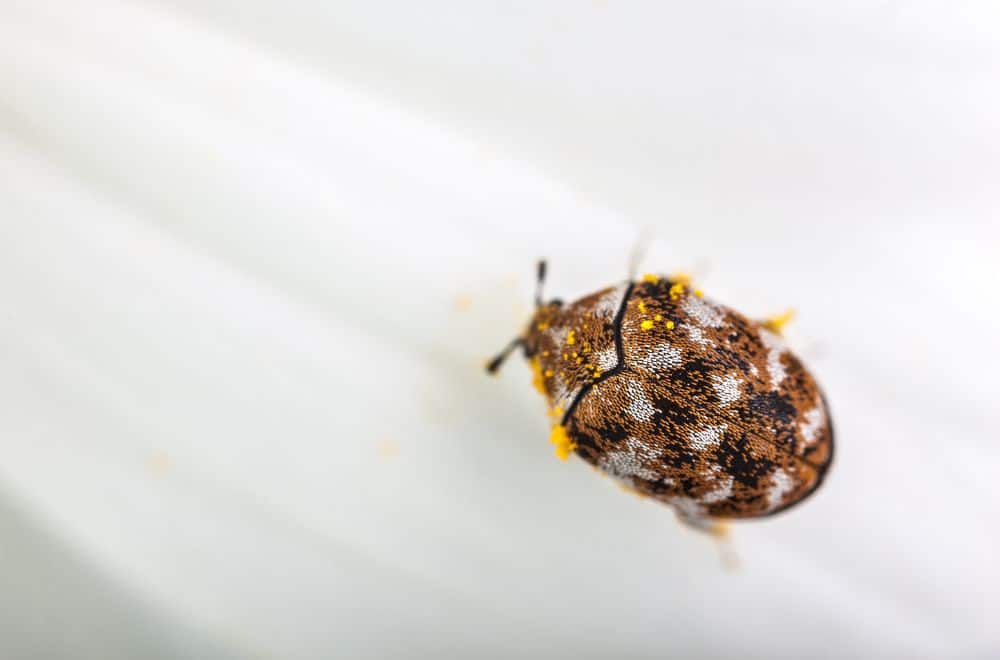Carpet beetles are probably not the first household pest bugs you would think of, but they are often present and cause much damage. They feed on pollen and nectar, but their larvae consume natural fibers, posing a danger to your wardrobe, upholstery, and carpets.
When it comes to these bugs, the main thing that appears to be unknown is how they affect people’s health. For instance, adult Carpet beetles don’t transmit infection, but larvae may cause allergic reactions. Primary questions are, do Carpet beetles bite, and how to eliminate them? Let’s see!
Carpet beetle types |
||
| Type | Size | Color |
| Varied Carpet beetle | 0.07 to 0.14 inches
(1.7 – 3.5 mm) |
An irregular pattern of white, yellow, and brown patches |
| Two-spot Carpet beetle | 0.18 to 0.24 inches
(4.5 – 6 mm) |
Very dark brown to black, with two spots on the wing cases |
| Brown Carpet beetle | 0.08 to 0.2 inches
(2 – 5 mm) |
Black with brown to reddish-yellow dense hairs on wings |
| Furniture Carpet beetle | 0.08 to 0.14 inches
(2 – 3.5 mm) |
Black with a yellow and white mottling of scales on the back |
| Black Carpet beetle | 0.12 to 0.2 inches
(3 – 5 mm) |
Black |
Carpet Beetles Characteristics
Carpet beetles go through egg, larva, pupa, and adult development stages. Both adults and larvae are small, while their appearance and color vary depending on their current life stage. Adults eat pollen and nectar, while larvae feed on fabrics. The most common Carpet beetle types are:
1. Varied Carpet beetles
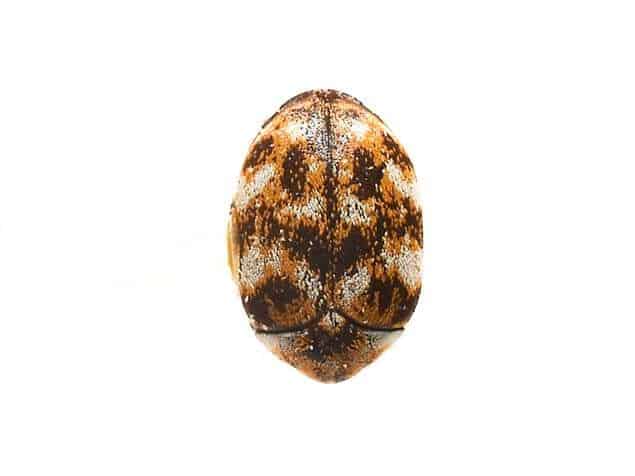
Image Credit: pestworld
Varied Carpet beetles are common round-shaped, 0.07 to 0.14 inches (1.7 – 3.5 mm) long household pests with white, golden yellow, and black scales. This beetle type has no specific color, but scales give it a mottled appearance.
Bugs’ legs and big eyes are black, while their head is small and hidden under the chest. You can recognize two bulging antennae with three upper segments making up the club. Adults typically live two to six weeks.
Carpet beetle larvae are approximately 0.16 to 0.2 inches (4 – 5 mm) long. Since their bodies are covered with hair, you can often find them under a nickname – Woolly bears. Larvae’s heads are orange to light brown, while their bodies are unevenly colored and look striped.
Segments behind the head are darker, while the light brown color prevails on the back. The abdominal region is the same color as body parts placed immediately behind the head, with dense tufts of hair growing backward.
Carpet beetle females lay eggs in batches of 20 to 100, always close to food sources, such as woolen fabrics, fur, and carpets. Eggs are white or creamy, so they effortlessly blend into their surroundings. That is why you can miss the infestation at this stage.
2. Two-spotted Carpet beetles
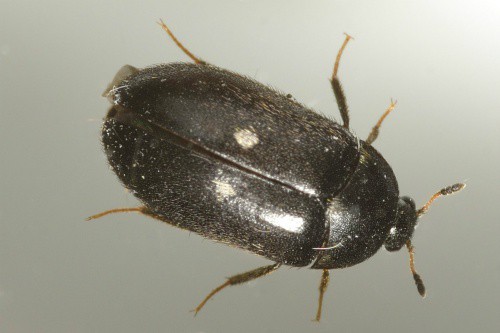
Image Credit: naturespot
Two-spotted Carpet beetles are also known as Fur beetles. They have oval, 0.18 to 0.24 inches (4.5 – 6 mm) long, dark brown to black bodies. You can also recognize two white spots on the wings.
Microscopic white hairs cover the entire beetle body surface. One part forms those two small white spots, giving these bugs their characteristic and recognizable appearance.
Two-spotted Carpet beetles have pointed antennae, with the males having particularly long posterior segments. Females are always more sizable and massive than males. The lifespan of both genders is about three months.
Larvae have golden-yellow to brown, torpedo-shaped bodies. They are over 0.25 inches (6.5 mm) long and taper from the head to the end of the abdomen.
You can recognize two strands of long orange hair on bugs’ lower parts. These larvae have a unique banded appearance thanks to the light and dark segment alternation.
Females usually lay eggs in wall cracks and tiny crevices near bird nests. This environment is crucial since it provides newborn larvae with a necessary food source.
3. Brown Carpet beetles
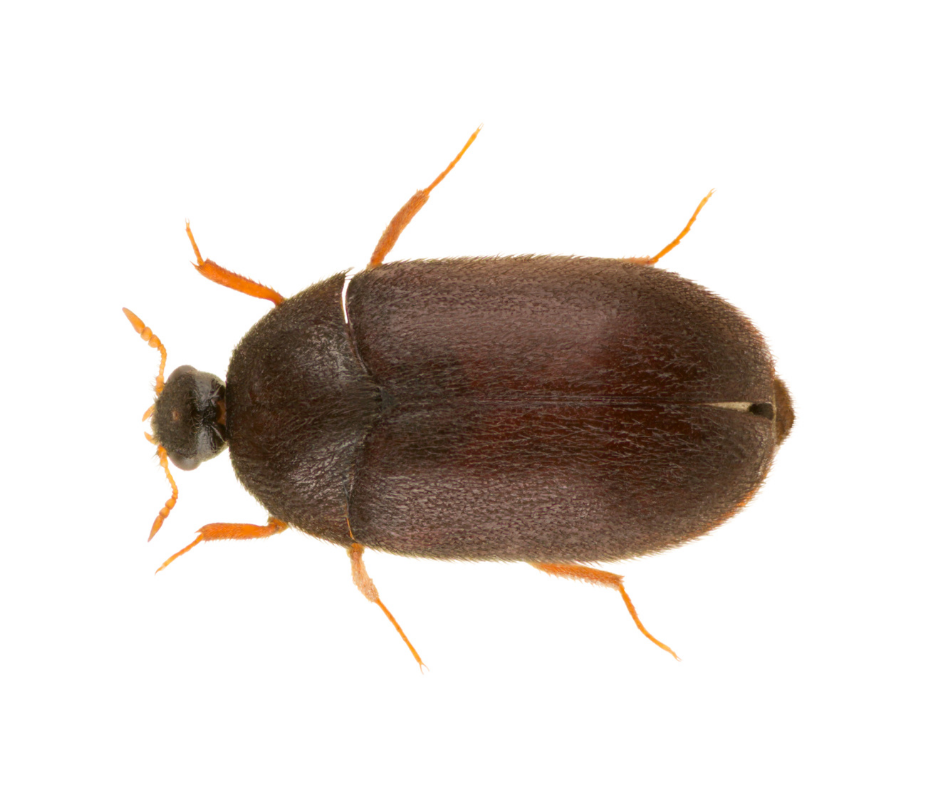
Image Credit: activepestcontrol
Brown Carpet beetles (Vodka beetles) have oval black, 0.08 to 0.2 inches (2 – 5 mm) long bodies and wings with thick, brown, to reddish-yellow hairs. They also have the ocellus, only one eye located in the middle of their heads.
This Carpet beetle type has a dark red-brown or black head and upper thorax with reddish-to-yellow legs and antennae. Although females are more sizeable, males have the last segments four times longer than the combined length of the previous two. Besides, they have longer antennae.
Their larvae are up to 0.31 inches (8 mm) long, with two brush tufts of hair continuing at the abdomen end. Their bodies are in a torpedo shape, which narrows from the head to the end of the belly.
You can notice clearly defined segments on the larvae’s bodies, giving them a striped appearance. As you can see, dark stripes are always wider than lighter ones.
Larvae’s bodies come in two shades so that you can recognize the bronze-brown color of the top side and the yellowish-brown shade from below. There are also visible golden-yellow hairs on the abdomen and thorax.
Females require plenty of food, high air humidity of 70 to 80%, and a temperature of 75.2 F (24 C) to lay eggs. They lay approximately 30 to 50 eggs in optimal conditions and choose various hiding places to settle them since future larvae can’t stand light.
4. Furniture Carpet beetles
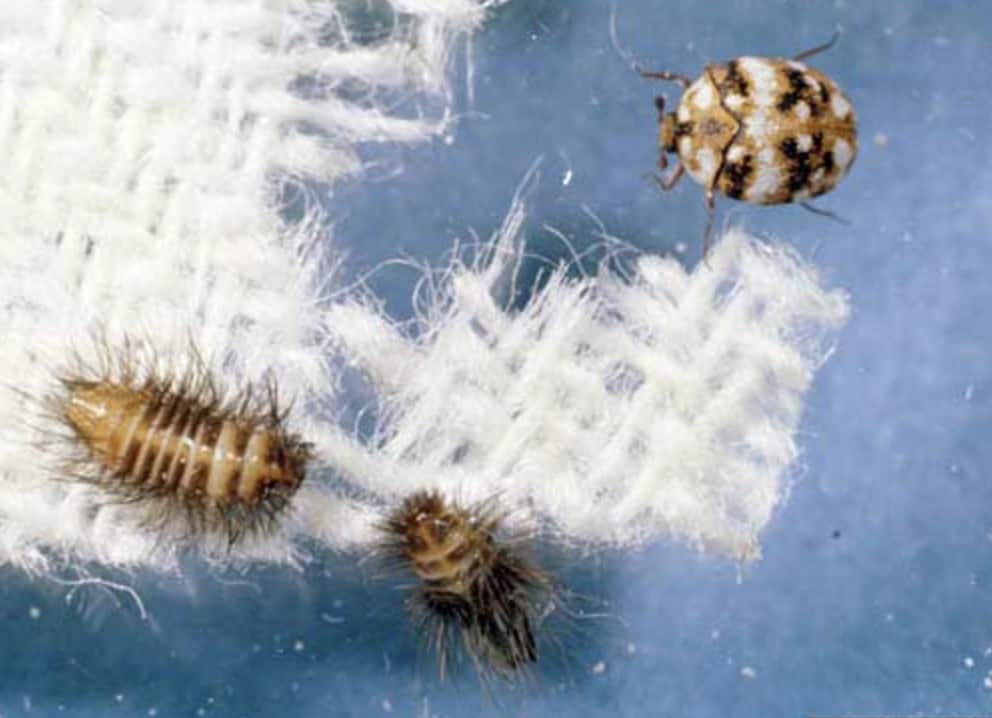
Image Credit: entnemdept
Furniture Carpet beetles are common pests of upholstered furniture. Like other beetle types, they can digest keratin from animal hair and feathers.
Their black bodies are approximately 0.08 to 0.14 inches (2 – 3.5 mm) long, and you can notice yellow-white scaly spots on their back and yellow scales on their legs. There are also two antennae on their heads with club-shaped tips.
Furniture Carpet beetles differ from other types because they have round or oval scales, unlike others with long and narrow ones. The lifespan of this beetle adult is from 30 to 60 days.
Furniture Carpet beetle larvae are 0.2 inches (5 mm) long and have oval-shaped bodies with brown hairs covering the entire surface. Their body color varies and depends on the food type they consume.
On the lower body part, just above the anus, is a tuft of hair known as the supra-anal organ. It constantly vibrates and serves as a defense against predators.
Eggs are white and still visible to the naked eye, even though they are smaller than 0.04 inches (1 mm). Females typically lay up to 100 eggs within their average life span of a month or two.
5. Black Carpet beetles
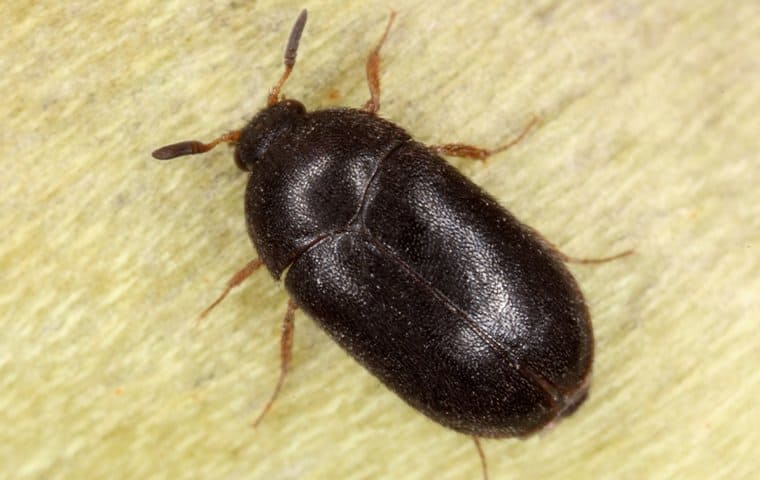
Image Credit: albemarlepestsolutions
Adult Black Carpet beetles have oval bodies of approximately 0.12 to 0.2 inches (3 – 5 mm) in length. These bugs are white at first but become darken to dark brown or black by the time they are fully grown.
An adult beetle never eats while spending time indoors while it feeds on pollen and nectar outdoors. Females usually start laying eggs after a week of entering your home and lay 50 to 100 eggs during their lifetime on average.
Depending on environmental factors and food availability, adults live nine months to three years. Their cigar-shaped black larvae can grow up to 0.28 inches (7 mm). Their bodies are narrow, dark brown to black, with short, stiff hairs. Older larvae can have long, bristly tails.
Larvae go through 5 to 11 molts depending on the environmental conditions. The larval stage takes up to three months when the circumstances are favorable, but it can be prolongated to two years when necessary.
Females typically lay their eggs on food sources or in their immediate vicinity. They are white and take five to 20 days to hatch when the surrounding humidity and temperatures are optimal.
In most cases, females lay eggs in dark, hidden places, such as basements, closets, and cracks in the floor or walls. Such an environment provides plenty of food for future larvae.
Do Carpet Beetles Bite?
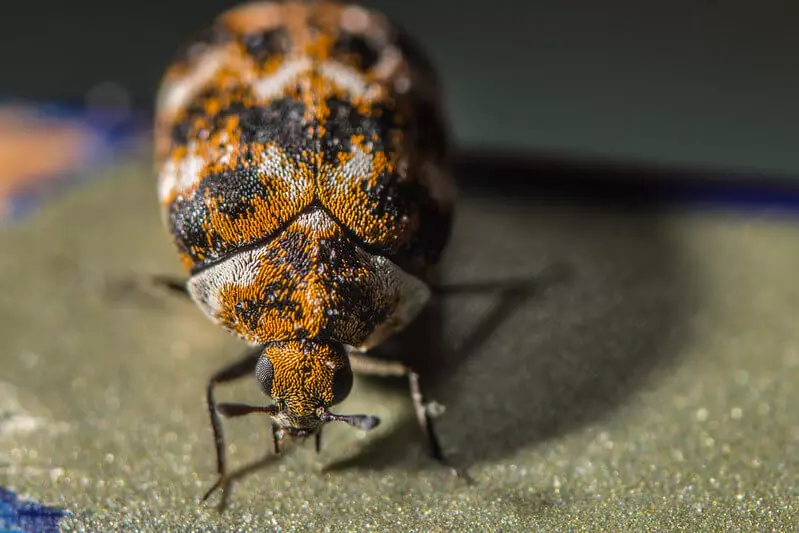
Image Credit: fantasticpestcontrol
Interestingly, neither adult Carpet beetles nor their larvae bite. Moreover, adult bugs never destroy fabrics despite their name, unlike their larvae. Since adults feed on pollen and nectar of plants, they have no teeth in their jaws, preventing them from penetrating human skin.
Larvae are also toothless but have small bristles that often cause an allergic reaction in humans. When you come across these creatures, your direct contact will end up with numerous health issues connected with your:
- Skin
- Eyes
- Digestive tract
- Airways and lungs
An allergy won’t occur in every person who comes into contact with the Carpet beetle larvae’s bristles. Likewise, the reaction strength will vary in intensity, depending on your sensitivity and immunity. The allergic reaction comes with symptoms that typically include:
- Red, itchy, and watery eyes
- Runny nose
- Itchy skin
- Rash and hives
- Gastrointestinal issues
A rash is the mildest symptom of an allergic reaction, and you can alleviate it without visiting a doctor. There are several efficient natural remedies you can use, such as:
1. Tea tree oil
This oil contains antibacterial properties that can help clear up rashes quickly. It is best to apply it directly to the affected skin.
2. Cider vinegar
Apply a paste made of three tablespoons of apple cider vinegar and one teaspoon of water to the skin rash. Make sure to rinse the skin with warm water after about ten minutes. Apply the mixture twice a day until the rash entirely disappears.
3. Vaseline or calamine lotion
Vaseline and calamine lotion may relieve your allergic reaction to Carpet beetle larvae touch. Always apply them directly to the affected area until itching and swelling decrease.
4. Medical help
As people’s allergic reactions to Carpet beetle larvae differ, medical help is sometimes the only option. When the reaction is violent, it is recommended to seek the advice of experts such as pharmacists and doctors.
Carpet Beetles Infestation Signs
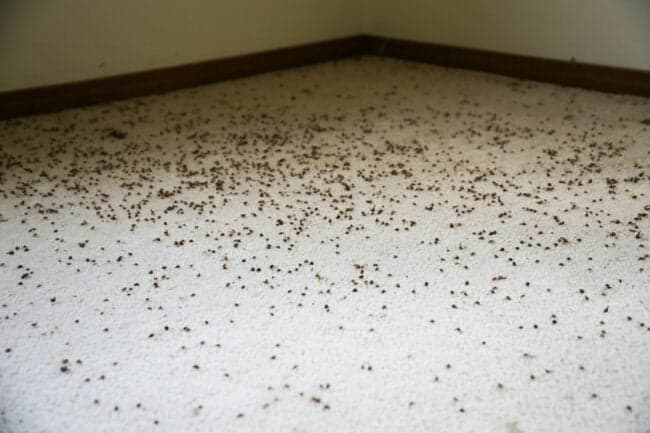
Image Credit: bobvila
Bright light always attracts adult Carpet beetles, so you can notice them around windows and light bulbs after entering your home. Unfortunately, their presence often means that larvae are also somewhere around, and common signs of their presence are the following:
- Holes in clothes, most often when they are stored for a long time
- Carpet smooth surfaces
- Fecal pellets near larvae feed sources
- Shed skin near places where they feed
- Skin irritation appearing without a visible reason
Ways to Eliminate Carpet Beetles and Prevent an Infestation
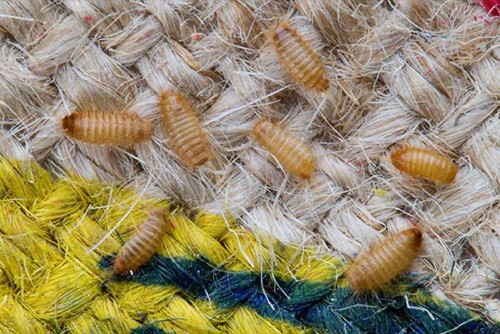
Image Credit: domyown
You can do several things to deal with these bug pests and prevent them from invading your home. Let’s take a look.
1. Vacuum regularly
Larvae feed on debris, such as dead skin, tiny insects, and pet and people’s hair. Regular vacuuming will remove these menaces and their food sources.
2. Steam cleaning
This cleaning method is suitable for floors and other hard surfaces. Like vacuuming, cleaning with warm steam will remove remaining larvae, bugs, and their eggs.
3. Washing machine
You can put clothes, curtains, bedding, and blankets suspected of infection in the washing machine. High water temperature will kill the larvae, but you need to be careful with this method. Always check the labels before washing and select the appropriate temperature, depending on the material type you want to wash.
4. White vinegar
One of the best natural ways to get rid of these bugs is to use white vinegar since it is a natural repellent. You can remove the dirt by spraying and wiping the shelves, windowsills, drawers, and hangers with a mixture made of white vinegar and water in a 50: 50 ratios.
5. Inspect plants
It is necessary to thoroughly check pot plants’ leaves and flowers before entering them indoors. Likewise, carefully shake cut flower stems and foliage to eliminate adult bugs feeding on pollen.
6. Gap sealing
Carpet beetles are small and easily find tiny cracks to crawl into your home. Check the door and window frames and fill all visible gaps. That way, you will prevent females from laying eggs there and future infestation in your home.
Summary
Unlike harmless Carpet beetles, their larvae can cause significant damage in your home when failing to spot them in time. Even though they are destructive to most fabrics, they never bite. Unfortunately, they may cause severe allergic reactions in humans, so their quick elimination should be your primary goal.
